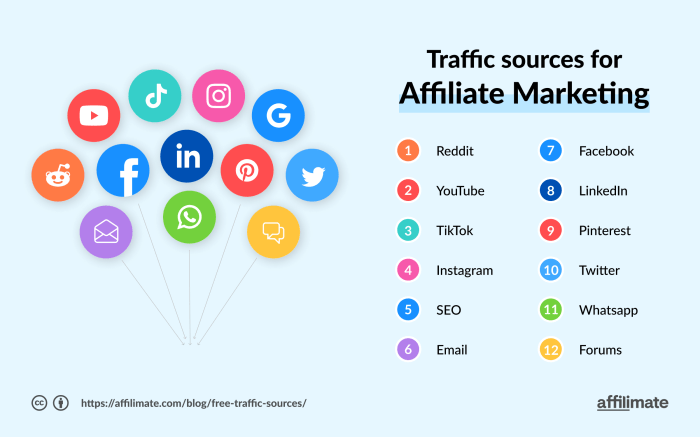Building an Affiliate Marketing Strategy kicks off our journey into the world of maximizing online revenue through strategic partnerships and engaging content. As we dive into the intricacies of affiliate marketing, get ready to unlock the secrets of success in the digital realm.
With each step, we’ll explore the key components that make up a winning affiliate marketing strategy, from setting SMART goals to selecting the right programs and optimizing performance for continuous growth.
Understanding Affiliate Marketing

Affiliate marketing is a type of performance-based marketing where a business rewards one or more affiliates for each visitor or customer brought by the affiliate’s marketing efforts. It’s essentially a way for companies to reach potential customers through a network of individuals or companies who promote the products/services in exchange for a commission.
Examples of Successful Affiliate Marketing Strategies
- Amazon Associates Program: Amazon’s affiliate program allows individuals to earn a commission by promoting Amazon products on their websites or social media platforms.
- ShareASale: ShareASale is an affiliate marketing network that connects companies with affiliate marketers to promote products and earn commissions.
- Bluehost Affiliate Program: Bluehost offers a lucrative affiliate program where individuals can earn commissions for referring customers to their web hosting services.
Benefits of Incorporating Affiliate Marketing
- Cost-effective: Affiliate marketing eliminates the need for upfront investment in advertising, as you only pay for results.
- Expanded reach: By leveraging affiliates, businesses can reach a broader audience and target specific niches more effectively.
- Increased revenue: Affiliate marketing can generate additional revenue streams for businesses through increased sales and conversions.
How Affiliate Marketing Works
Affiliate marketing works by having affiliates promote a company’s products/services through unique tracking links. When a customer clicks on the affiliate link and makes a purchase, the affiliate earns a commission. This process helps drive traffic and sales for businesses while providing affiliates with a way to monetize their online presence.
Setting Goals for Affiliate Marketing Strategy
Setting goals is crucial for the success of any affiliate marketing strategy. It helps in measuring performance, staying focused, and aligning efforts with overall business objectives.
Identify Key Performance Indicators (KPIs)
- Determine metrics such as conversion rate, click-through rate, average order value, and revenue generated.
- Track the number of leads generated, customer acquisition cost, and return on investment (ROI).
Setting Realistic Goals
- Consider current performance data and industry benchmarks to set achievable targets.
- Aim for gradual growth and improvement rather than unrealistic overnight success.
Aligning Goals with Business Objectives
- Ensure that affiliate marketing goals complement and support the overall business strategy.
- Focus on driving relevant traffic, increasing sales, and expanding brand reach.
Importance of SMART Goals
-
Specific:
Clearly define what you want to achieve with your affiliate marketing efforts.
-
Measurable:
Set quantifiable targets that can be tracked and evaluated.
-
Achievable:
Ensure that your goals are realistic and within reach based on resources and capabilities.
-
Relevant:
Align affiliate marketing goals with the overall business objectives and target audience.
-
Time-bound:
Establish deadlines and timelines for achieving specific milestones and objectives.
Selecting the Right Affiliate Programs: Building An Affiliate Marketing Strategy

When it comes to affiliate marketing, choosing the right affiliate programs is crucial for the success of your strategy. Here, we will discuss the different types of affiliate programs available and provide tips on how to select the most suitable ones for your specific niche.
Types of Affiliate Programs
- Pay-Per-Sale (PPS): Earn a commission for every sale made through your affiliate link.
- Pay-Per-Click (PPC): Earn a commission for every click on your affiliate link, regardless of whether a sale is made.
- Pay-Per-Lead (PPL): Earn a commission for every lead generated through your affiliate link.
Tips for Choosing Affiliate Programs, Building an Affiliate Marketing Strategy
- Consider the commission rates offered by different programs. Higher rates can lead to higher earnings.
- Look at the cookie duration, which determines how long you can earn commissions after a visitor clicks on your affiliate link.
- Ensure the products or services offered by the affiliate programs are relevant to your niche to increase conversion rates.
Importance of Partnering with Reputable Programs
Partnering with reputable affiliate programs not only ensures that you will be paid for your efforts but also helps build trust with your audience.
Creating Engaging Content for Affiliates
Creating engaging content is crucial in driving affiliate conversions. High-quality content not only attracts potential customers but also helps in building trust and credibility, ultimately leading to more sales for affiliates. Here are some strategies and tips for developing compelling content that can boost your affiliate marketing strategy:
Utilize Reviews, Tutorials, and Comparison Guides
- Reviews: Write detailed and honest reviews of products or services you are promoting. Include personal experiences, pros and cons, and relevant information that can help potential buyers make informed decisions.
- Tutorials: Create step-by-step tutorials on how to use a product or service. This type of content not only educates your audience but also showcases the benefits of the product in action.
- Comparison Guides: Compare different products or services within the same niche. Highlight the unique features, pricing, and benefits of each option to help your audience choose the best fit for their needs.
Optimizing Content for Search Engines and Affiliate Marketing
- Research: Conduct thorough research to identify relevant s that can drive organic traffic to your content. Incorporate these s naturally throughout your content for better visibility.
- Quality and Relevance: Ensure your content is informative, engaging, and relevant to your target audience. High-quality content not only attracts readers but also encourages them to take action.
- Call-to-Action (CTA): Include clear and compelling calls-to-action in your content to prompt your audience to click on affiliate links or make a purchase. CTAs should be strategically placed and enticing.
Promoting Affiliate Links Effectively
When it comes to promoting affiliate links, it’s essential to strike a balance between showcasing products/services and providing valuable content to your audience. Being overly promotional can turn off your followers, so it’s crucial to integrate affiliate links in a way that feels natural and authentic.
Integrating Affiliate Links Ethically
- Disclose your affiliate relationships: Transparency is key when it comes to affiliate marketing. Make sure to disclose your partnerships with companies to maintain trust with your audience.
- Choose products/services you believe in: Promote products/services that align with your values and that you genuinely recommend. This authenticity will resonate with your followers.
- Provide value first: Focus on creating high-quality content that provides value to your audience. Then, seamlessly integrate affiliate links where they make sense within your content.
Leveraging Social Media and Email Marketing
- Social media: Use platforms like Instagram, Facebook, Twitter, and Pinterest to share affiliate links. Create engaging posts that highlight the benefits of the products/services you’re promoting.
- Email marketing: Incorporate affiliate links into your email newsletters, but make sure not to overwhelm your subscribers with too many promotions. Personalize your emails and make recommendations based on their interests.
Analyzing and Optimizing Affiliate Marketing Performance
Tracking and analyzing affiliate marketing performance metrics is crucial for the success of any affiliate marketing strategy. By monitoring key data points, marketers can identify what is working well and what needs improvement, allowing them to optimize their campaigns for better results.
Importance of Tracking and Analyzing Performance Metrics
- Tracking metrics such as click-through rates, conversion rates, average order value, and ROI helps marketers understand the effectiveness of their affiliate campaigns.
- By analyzing these metrics, marketers can identify top-performing affiliates, high-converting content, and successful promotional strategies.
- Tracking performance data also provides insights into customer behavior, preferences, and trends, enabling marketers to make data-driven decisions for optimization.
Tools and Techniques for Monitoring Affiliate Marketing Results
- Utilize affiliate tracking software and analytics platforms to monitor key performance indicators in real-time.
- Set up tracking links, pixels, and cookies to accurately track affiliate referrals, conversions, and sales.
- Implement UTM parameters to track affiliate campaign performance across different channels and campaigns.
Strategies for Optimizing Affiliate Marketing Campaigns
- Use performance data to identify underperforming affiliates, low-converting content, and ineffective promotional tactics for optimization.
- Experiment with different commission structures, incentives, and bonuses to motivate affiliates and improve performance.
- Optimize landing pages, creatives, and calls-to-action based on performance data to enhance conversion rates and user experience.
Tips for A/B Testing and Iterating on Affiliate Marketing Strategies
- Conduct A/B tests on different affiliate creatives, offers, and landing pages to determine the most effective variations for maximizing conversions.
- Iterate on affiliate marketing strategies based on A/B test results, continuously refining and optimizing campaigns for better performance.
- Monitor performance data regularly, test new ideas, and adapt strategies to changing market trends and consumer preferences for sustained success.








